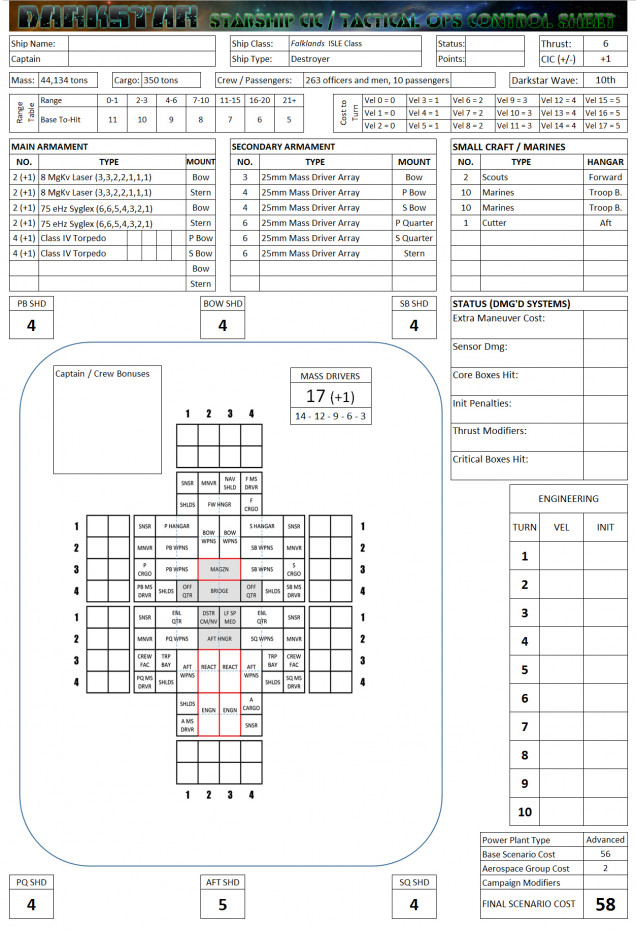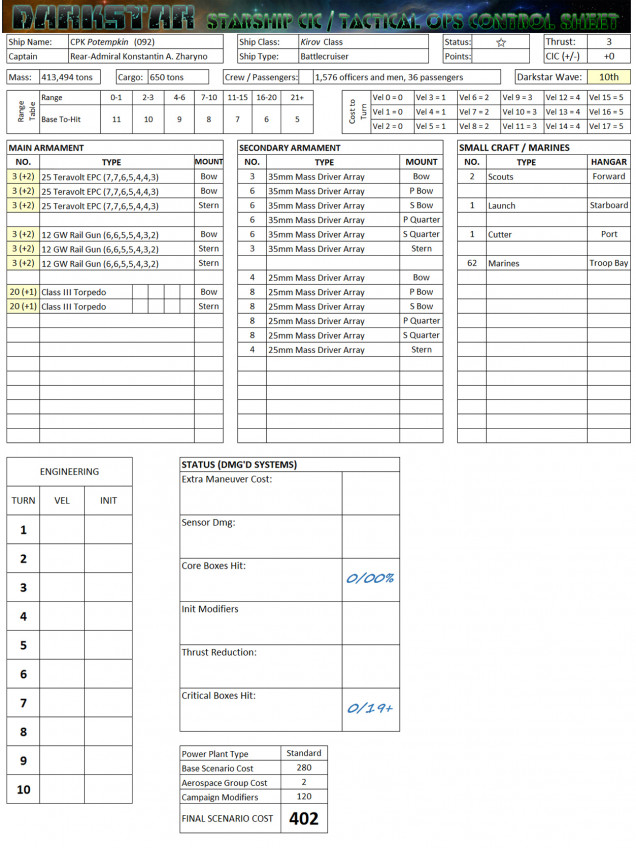
Persei-Aries War Resumes
New Warships - Falklands-ISLE upgrade and Kirov-class Battlecruiser
Here are some new warship classes I’ve been working on for Darkstar.
The first is a new upgrade made to the British Falklands class destroyer, much the same way we did for the Valcour class (USS Oriskany) before.
The Falklands has been a fan favorite of the community ever since I brought Darkstar to the OTT community, with at least four players having at least one in their fleets. At least two players have told me its one of their favorites, and two of them (HMS Sheffield and HMS Burke) are well on their ways to becoming the next “USS Oriskany” – legendary destroyers of the Darkstar ‘verse. 😀
The second ship presented … wait for it … the Russians finally have a battleship. Technically she’s a battlecruiser, the Kirov class (obvious homage to the Cold War era Kirov class nuclear-powered missile battlecruiser). This one’s already been upgraded and will now form the core of the Russian force in tomorrow’s game against @rasmus and @muakhah!
When the Falklands class destroyer was first brought into service, many within the Royal Navy doubted the newest “glass cannon” in the fleet. A personally-sponsored program of the immensely powerful and influential Lord Admiral Nathaniel Byron Annistaire, he pushed the design and construction of these ships after the death of his son Daniel aboard the aging Bristol class destroyer HMS Stamford. This intense personal attachment, the high cost of the Falklands design, and the lack of any real improvement in shielding, armor, or speed, made many question whether Annistaire’s “pet destroyers” were really worth it.
Sixteen years later, the debate is over. Since 2504 the Falklands has proven the most capable (and most sought-after) destroyer design in the FTL-era history of the Royal Navy. An entire spin-off class has been commissioned (the Commonwealth class) and units continue to be produced to this day. Famous ships of this class include the HMS Burke (Commander Robert Lewis), HMNZS Aotearoa (Commander James Matapaere), HMS Singapore, HMS Dignity and especially HMS Sheffield (Commander Howard Bowen).
Finally the decision was made to prepare this ship for the next two decades of service. This was the “In-Service Life Extension” program (ISLE), a particularly fitting suffix to the “Falklands” name of the class. The HMS Sheffield was the first ship selected to undergo the overhaul and refit after completing her tour during the Third Hercules War in mid-2522. Work started at the Lucy’s Hope shipyards (Hawking’s Star / HR 6806 star system) in August of that year, and completed in January 2523.
The Falklands ISLE program was a comprehensive upgrade of the ship’s protection package, weapons suite, point-defense systems. Aft shielding was amplified, the gravitic curvature of the generator increased by 20%. This was an important upgrade, since directly aft is the facing most commonly targeted by enemy torpedo, missile, and aerospace strikes. The point-defense system was also modernized, with the older, slower-firing 35mm systems upgraded with new Hispano-Vickers 25mm systems, mostly in triple mounts, and double mounts port and starboard.
Offensive systems were also upgraded, with the biggest single improvement coming to the deadly BAE “Sabre” class 75 exohertz syglex emitters (x-ray lasers). Where the Falklands class formerly mounted two of these weapons (one fore and one aft), the Falklands-ISLE now mounts a double-gun turret. Redesigned gravitic lenses, optimized power couplings, and redesigned mounting braces have allowed two guns to be twin mounted in an expanded turret ring assembly. Admittedly this was the most difficult part of the upgrade, requiring the complete restructure of at least six decks of both the fo’c’sle and quarterdeck areas of the ship. Power relays also had to be greatly expanded from the newly-upgraded Johnston-McAuley Aerospace DT-Fusion engines, not only to the new shielding and mass driver arrays, but especially these oversized new syglex emitters.
Lastly, the torpedo array was expanded from three tubes on the port and starboard bow racks, to four on each rack.
In all, this has resulted in seven new crew aboard, an additional 2300 tons in mass, and 5.5% additional power draw on average. But the Falklands ISLE class can still pull the same acceleration curve, and make the same 10-mag Darkstar Waves in FTL.
Four ships were eventually selected to undergo this refit. Only the future can tell whether these upgrades will prove the value of the investment, and if these esteemed destroyers will continue their winning record through the 2520s and beyond.
The Kirov class battlecruiser is a something of an odd design, considered by some to be the “least Russian warship in the Russian navy.” Indeed, her design choices seem to heavily draw from similar designs of other navies, like the Prussian Scharnhorst class or the British Cross class. Not quite powerful enough to lock horns with a true battleship but easily capable of breaking heavy cruisers in half, a Kirov battlecruiser trades the firepower of a true dreadnought for additional speed. The general idea is that this speed will extend cruising and maneuver envelopes beyond the capabilities of likely opponents, allowing a Kirov to choose the angle and time of engagement, the range of fire exchange, and the point of disengagement. In plainer language: “She can outrun anything she can’t outfight, and outfight anything she can’t outrun.”
This design principle is borne out in the weapons systems. Note she does not have a primary battery and a secondary battery, but two primary batteries. The 25-teravolt EPCs are admittedly heavier, but not only do they hit harder, but at much longer range than most Russian warships (normally famous for their blistering batteries of short-range, high-yield plasma accelerators). The Kirov can kill at a distance, something not usually seen in Russian warships. These are also the forward-weighted mountings (two turrets forward), allowing the approach Kirov to choose the aforementioned range. Meanwhile, the 12-gigawatt rail guns mount two turrets aft, closer-range weapons clearly meant to defend against smaller, faster cruisers and destroyers looking for a swing around the Kirov’s stern.
In some ways the Kirov is better than its rivals. While not as fast as the Scharnhorst, the Kirov mounts a far more impression gunnery suite. That said, it is not as accurate as the Prussian counterpart. Then again, Russian analysts have seen that dreadnoughts are taken out by massed torpedo attack as often as anything else, and mount a point-defense array of 25mm quad-mounts and 35mm triple mounts that make the Scharnhorst green with envy. This leads at least one American admiral to comment: “Battlecruiser my ass. She’s a fast battleship, same as our Colorados.” He may be correct, except the Kirov also mounts two massive racks of no less than twenty tubes for the P-500 “Plamya” (Plame) torpedo … a weapon for which a Colorado class has no answer.
All that said, the Kirov does have weaknesses. Like all battlecruisers, she has underpowered guns (compared to a true battleship) and underpowered shielding. Conversely, although faster than most battleships, she’s slower than any heavy cruiser class in known space. Accordingly, any Kirov commander has to know that he’s going into battle with a shortcoming that a savvy opponent can exploit. Also, although impressive in number, the P-500 is painfully slow and highly inaccurate. Furthermore, the Kirov ship is clearly set up as a “broadside” ship, with all weapons (even the torpedoes) arrayed along the ship’s centerline. While this allows for great broadside firepower, is also crams the weapons systems and their power, control, ammunition, and crew systems into tightly-compacted compartments within the ship that sometimes lead to cascading systems failures when damaged in combat. And finally, with a mass of 413,494 tons and crew of almost 1600 officers and men, a Kirov battlecruiser is exorbitantly expensive to build and operate.
In terms of aesthetic, the Kirov’s lines are a combination of sleek yet brutish, streamlined yet bristled, an odd blend of cutting speed somehow combined with hulking intimidation. In this regard the battlecruisers are something of prestige ships, showing the flag at far-flung colonies and carrying diplomats to high-stakes negotiations. Clearly the Holy Russian Navy is proud of these vessels, and plans to keep them for decades into the future.

































![How To Paint Moonstone’s Nanny | Goblin King Games [7 Days Early Access]](https://images.beastsofwar.com/2024/12/3CU-Gobin-King-Games-Moonstone-Shades-Nanny-coverimage-225-127.jpg)









































The Kirov is a beast – 2 Battle ships in my last two battles … I have to get into one of them at some point
She’s a beast, @rasmus , that’s for sure. Wait until the Peter the Great class comes out! 🙂
I love “sleek yet brutish”! Perfect description for a Russian fleet!
Soviet warships of the Cold War era were often so beautiful. Not always the most effective, but badass looking. The real-life Kirovs (later Admiral Ushakov) are some gorgeous ships.